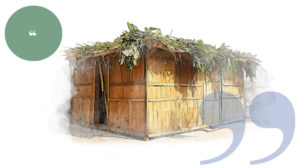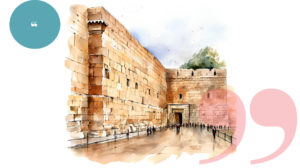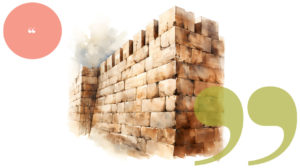The Count-Up

How does the act of counting serve as a cleansing agent? What is the meaning of the prayer’s reference to “today’s Sefirah”? And what is the “Omer” in “Sefiras Ha’omer”?
There’s nothing quite like the moment of arrival.
It’s an exquisite, emotional moment when we sit down to the Seder on the first night of Pesach. The countdown is over, our efforts have culminated in the beautiful table we’re siting at, and we’ve reached our journey’s end.
Before we have a chance to ask, “What’s next?” we’re immediately cast into another, more formal countdown: Sefiras Ha’omer begins the very next day. While most of us know that we’re counting up to Shavuos, and demonstrating, in the words of the Sefer HaChinuch, “our longing and expectation for that exalted day,” we may not fully understand the relevance of these weeks.
Counting the Omer is not merely an emotive expression of our anticipation for Kabbalas HaTorah. It’s a process of growth. We seek not only to reach the day of Matan Torah, but to get there in a purified, elevated state. In the tefillah some recite after the daily Sefiras Ha’omer, we ask Hashem “in the merit of the Omer that I have counted today, may any blemish I have caused in today’s Sefirah be corrected, so that I can be cleansed and sanctified.”
How does the act of counting serve as a cleansing agent? What is the meaning of the prayer’s reference to “today’s Sefirah”? And what is the “Omer” in “Sefiras Ha’omer”?
Each Day Counts
The key to understanding Sefiras Ha’omer is the manner in which we count, which is atypical in two ways. First, we don’t count down to Matan Torah, we count up. The numbers increase from day to day. On the first day we don’t say there are 48 more days, instead we declare “Today is one day.”
Second, it’s inaccurate to say that we count the individual day. Rather, we announce the total number of days that have elapsed. We don’t say, “Today is the second day,” rather we declare, “Today is two days.”
Imagine, says Rav Pincus, that someone desperately needs to come up with a million dollars by a particular date, 100 days away. Let’s contrast two possible scenarios: He finds a generous relative who will give him the entire sum on that deadline. Alternately, he finds a generous relative who will hire him for the next 100 days at the rate of $10,000 per day, so he’ll finish earning the money on the required date.
In the first case, the 100-day wait period is a barrier between him and the money he needs so badly. His fanciful wish is for these days to disappear completely. As he urgently waits for the time to pass, he counts down, “Ninety-nine more days,” “ninety-eight more days…”
In the second case, all 100 days are essential, for each day adds another $10,000 to his goal. If any of these work days were canceled, he wouldn’t meet his goal! As he marks off each day of work, he thinks, “Today I have $10,000 toward my goal,” “Today I have $20,000….”
In a similar vein, we don’t merely anticipate Matan Torah, and our count is not only verbal. We consciously prepare ourselves to receive and deserve the prized gift of the Torah. Each day of Sefiras Ha’omer is crucial and valuable, because if it’s used properly, it brings us one step closer to our goal. As we count, we savor the time well spent, and we revel in the accomplishments we’ve accumulated thus far. Today is not “the fifth day of the Omer”; instead, we’ve now acquired “five days of the Omer.”
Shaping Up
Rav Moshe Shapiro points out that the word omer means a pile or bundle.
But we are not only fashioning a bundle of days. We are fashioning ourselves. Torah sources liken the Exodus from Mitzrayim to our birth and Matan Torah to our coming of age. The 49 days of the Omer are the days of our maturation. We’re engaging in the process of becoming more — more developed, more integrated, and more complete — and our manner of counting reflects this. Each successive day is the culmination of our past experiences and strivings.
The Zohar writes that each day of Sefirah marks a step away from the defilement of Mitzrayim and a step toward spiritual purity. This is how we prepare for receiving the Torah, and this explains why the above mentioned tefillah speaks of being cleansed from contamination. It’s not a coincidence that Sefirah coincides with spring, the season of growth. At the time that the crops ripen to provide for our material needs for the entire year, Hashem gives us the parallel opportunity to nourish our neshamos for the whole year.
The Omer refers to the minchas ha’omer, an offering from the new barley crop, which was brought to the Beis Hamikdash on the second day of Pesach. Another meal offering, the shtei halechem, is brought on Shavuos from the new harvest of wheat. The commentaries indicate that the progression from barley to wheat, from animal feed to human food, reflects the progress we’ve made over the course of these seven weeks.
Indeed, Rav Shalom Sharabi, a talmid of the Arizal, writes that the days of Sefirah are the root of the entire year. One’s stature in these days determines the nature of his year. If he doesn’t elevate himself during these days, he’ll have missed an opportunity that cannot be regained even during Tishrei. He will not arrive at the right place.
On the Count of Seven
How does one prepare for the Torah?
The Arizal writes that 49 can be broken down into 32+17, which correspond to the gematria of lev and of tov. Lev tov means a good heart. Our Sages assert that a good heart — good character traits — is the prerequisite for Torah. Thus, the work of these seven weeks centers on self-perfection.
Moreover, the key numbers of the period of Sefirah, seven and 49, both reflect the theme of building and finishing. Ever since the world was created in seven days, the number seven denotes a complete set. Seven weeks, or 49 days, is even more comprehensive, for each unit of seven branches out to its own set of seven. In this sense, we’re building a person who is fully developed in all dimensions.
More specifically, the seven weeks between Pesach and Shavuos correspond to the Seven Sefiros, a spiritual reality mostly unfathomable to us. Zecharyah Hanavi speaks of “seven eyes,” and of “the eyes of Hashem roving over the entire earth” (4:10). The Malbim and others explain that this is a metaphorical reference to the Seven Sefiros, or attributes, with which Hashem created the world and with which He governs the world.
The Seven Sefiros are: Chesed, Gevurah, Tiferes, Netzach, Hod, Yesod, and Malchus. They’re derived from the verse we recite daily, “To You Hashem, belong the greatness (chesed), the strength (gevurah), the harmony (tiferes), the eternity (netzach), the beauty (hod), for all that is in the heavens and the earth (yesod, foundation) is Yours, and Yours is the kingdom (malchus)” (Divrei Hayamim I, 29:11).
The Ramchal points out that the word sefiros means “counting,” indicating that they have a measure and a limit. Although Hashem is infinite, He has chosen to reveal these attributes and not others, for these relate to us in the lower realms. For example, sometimes we perceive the Sefirah of Chesed, His loving kindness at work; other times, we may perceive Gevurah, His strength and restraint. It’s important to understand that the Sefiros are not Hashem’s essence, of which we have no knowledge. Rather, they’re the channels through which He guides the world at any given moment.
If the Sefiros are largely esoteric, what is their relevance to us? The Arizal explains: We were created b’tzelem Elokim, in the image of G-d. This is our essential definition — our identity, our potential, and our destiny. One of the most important implications of this fact is that we must model our behavior after His attributes. As we study the Sefiros, we gain knowledge of Hashem and of ourselves. Thus, we can define ourselves and refine our relationship with Him.
And there’s much more. In kabbalistic thought, man is termed an olam katan, a microcosm of the world. Just as Hashem created the olam gadol, the universe, with the Sefiros, similarly, we build our personal world with these middos. And just as Hashem relates to mankind through the Sefiros, we relate to our fellow men by means of these seven facets.
Even more startling is the fact that our actions cause an equivalent reaction in the macrocosm, the universe. When we utilize the Sefiros properly, Hashem responds accordingly. Thus, if a person uses middas hachesed in the right context, he activates the middas hachesed of HaKadosh Baruch Hu. And when we rise above our own personal nature — which is what tikun hamiddos is all about — Hashem will bend the world’s laws of nature on our behalf. What power we wield, and what responsibility comes with that power!
This power was granted to us at Matan Torah when Hashem chose us as mamleches kohanim v’goy kadosh, a kingdom of priests and holy people (Shemos 19:6). Every year, we reexperience Yetzias Mitzrayim, and then, 49 days later, we arrive yet again at Har Sinai, and we receive this key, the key to the entire universe, all over again. The Sefiros are crucial to this journey.
What’s fascinating is that each of the Seven Sefiros is associated with one of the shivas ha’roim, the seven shepherds, or leaders, of our people. They are familiar to us from the Yom Tov of Succos, when they are identified as the Ushpizin: Avraham, Yitzchak, Yaakov, Moshe, Aharon, Yosef, and Dovid. They were builders — they built themselves, they built Klal Yisrael, and they rebuilt the world after the cheit of Adam Harishon compelled the creation of a new world order, or tikkun olam. Each of the Ushpizin perceived Hashem in a particular way and personified the corresponding middah. Avraham, for example, saw Hashem as a G-d of Chesed and developed that middah, Yitzchak saw Him as a G-d of Gevurah, and excelled in restraint, and so on.
The shivas ha’roim engaged in tikkun olam; during the weeks of Sefiras Ha’omer, we follow their lead and engage in the tikkun of the miniature world, the olam katan that is ourselves.
Although there are seven different Sefiros, they interlock with each other and work together. For this reason, although the first week of Sefiras Ha’omer is the week of Chesed, it’s broken down into smaller parts. As we study Hashem’s chesed and try to apply it to our own relationships, we recognize that different situations require different nuances and different emphases. Thus, the first day is designated as Chesed Sheb’chesed, kindness within kindness, the second day is termed Gevurah Sheb’chesed, restraint within kindness, the third day is Tiferes Sheb’chesed, and so on. Each day we combine Chesed with a different quality.
On each successive week, we focus on another virtue and combine it with the other ones, until, at the end, we’ll have covered 49 combinations of the Seven Sefiros and built a complex structure of an integrated, comprehensive personality.
We begin with day one of week one, Chesed Sheb’chesed, and, seven weeks later, we arrive at day seven of week seven, Malchus Sheb’malchus, majesty within majesty. We are then ready to assume our role of royalty in the world and to proclaim Hashem’s sovereignty. And that is the ultimate, most joyful arrival of all.
Sources include the teachings of the Ramchal, Rav Dessler, Rav E. Kitov, the Slonimer Rebbe, Rav Pincus, Rav Moshe Shapiro, and Rav Aryeh Leib Shapiro
LIFE SONG OF KINDNESS
“Kindness begins at home,” goes the aphorism, but a twist on these words provides a more fundamental perspective: “Home begins with kindness.”
Our home is the universe, and it was created by Hashem upon the foundation of chesed. In the words of Tehillim (89: 3), “Olam chesed yibaneh — the world is built on chesed.”
The Torah, blueprint of the universe, opens with an act of kindness: Hashem provides clothing for Adam and Chava after their sin (Sotah 14a). Furthermore, the olam hatikkun, the world of rectification after Adam’s sin, begins with Avraham Avinu, the epitome of chesed.
The primacy of chesed is true on a personal level as well. As Rav Chaim Vital writes, “Middos tovos, good character traits, are the vehicle that brings the Shechinah to dwell among us. And at the head of all middos tovos stands the attribute of chesed.”
A Good Start
Since chesed is the foundation of creation, it’s the first of the Seven Sefiros we focus on during Sefiras Haomer. The Sefiros are the seven attributes Hashem used to create the world, and which He continues to use to govern the world. They serve as a guide for our own behavior.
In the verse that describes the Seven Sefiros, Chesed is referred to as gedulah — greatness and magnitude. When Avraham Avinu looked at the vastness and intricacy of creation, he beheld a world that exhibits benevolent kindness. He saw a myriad of complex creations designed for man’s comfort, enjoyment, and pleasure. He saw a world that spoke of a kind, giving King.
Not only did he discover Hashem’s presence by observing an olam of chesed, but Avraham then followed in Hashem’s ways, personifying middas hachesed.
Avraham recognized that olam chesed yibaneh doesn’t only mean that the world was founded on chesed; it also means that the world continues to exist in the merit of people who perform chesed.
The Midrash identifies the catalyst for Avraham’s embarking on a life of chesed. It tells of a conversation between Avraham and Shem, the son of Noach. To Avraham’s query as to what merit saved the family from the Mabul, Shem replied that it was in the zechus of the round-the-clock care they extended to the animals for the full year they spent in the teivah.
Avraham’s response was personal and immediate. “These people survived only because they were kind to animals; if I am kind toward human beings, who are similar to angels, I will surely be saved from adversity.”
Avraham did not merely act kindly toward others; kindness defined every facet of his behavior and personality. In recording an exchange between Hashem and Iyov, the Midrash pinpoints the difference between a kind person and an individual who personifies chesed.
Iyov wondered why his benevolence toward others didn’t protect him from punishment: “Have I not fed the hungry? Dressed the unclothed?”
“Your chesed has not attained half the measure of the chesed of Avraham,” replied Hashem. “You sit at home and wait for guests to come to you. You offer wheat to those accustomed to wheat, serve meat to those who prefer meat, and give wine to those used to drinking wine. Avraham didn’t merely wait for visitors to appear. He actively sought guests, and he offered wheat to those unaccustomed to eating wheat, meat to those who don’t normally eat meat, and wine to those unused to drinking wine.”
How did Iyov fall short of Avraham Avinu? And how does this contrast refine our understanding of the ultimate degree of gemilus chasadim?
If Avraham learned the middah of chesed by observing the actions of His Creator, we can find answers by examining the chesed Hashem manifests.
Pursuing Kindness
Just as we cannot fathom Hashem’s essence, so we will not fully understand why He created the world. Yet the Ramchal offers us an astonishing insight: Hashem created the world in order to perform chesed. He created people in order to create receivers of His beneficence.
Thus, we have another understanding of olam chesed yibaneh: Not only did Hashem create a world that demonstrates and displays chesed, but He created it for the very purpose of doing chesed. In the words of the Ramchal in Daas Tevunos: “The Creator is the very essence of good. It is the nature of good to bestow good on others. This is why He created people — so that He can bestow good upon them.”
Rav Chaim Friedlander points out that we express this concept in the brachah of borei nefashos. We note that Hashem created nefashos rabos v’chesronon — many living things with lacks and needs. Why? L’hachayos bahem nefesh kol chai, in order that He can sustain them by supplying their needs.
A true giver wants to give, regardless of whether there are receivers in need of his generosity. Every schoolchild knows what happened when Avraham Avinu, weakened from his recent bris milah, anxiously scanned the horizon, searching for guests he could host. His need to give was so great that Hashem created the opportunity for him to do so by bringing him three visitors — Hashem created the recipients! Yet, if no one really required hospitality, why was Avraham distressed?
There are two different forms of chesed. Iyov gave by fulfilling the needs of his guests. If someone arrived at his doorstep, he supplied him with resources commensurate with the guest’s expectations. As commendable as this is, it’s a response, not an initiative. This form of giving falls under the rubric of interpersonal relationships and is based on the mitzvah, “V’ahavta lerei’acha kamocha.”
The most superior form of chesed, is not reactive, but proactive. It’s rooted in our relationship with Hashem, in the mitzvah of “V’halachta b’drochov.” The individual passionately seeks to become a giver, to create a flow from giver to receiver, just as Hashem does. He remains in “giving mode” at all times, poised and ready to do chesed, regardless of whether or not there is a needy receiver presenting at that moment.
Just as Hashem created a world in order to give, the giver persists in generating opportunities to do good. Avraham actively sought guests and offered them foods they never tasted before, opening up new possibilities of enjoyment for them, and new opportunities of giving for himself.
The altruistic baal chesed doesn’t think about receiving anything in return, he doesn’t question the beneficiary’s relationship to him, and he doesn’t wonder whether the recipient truly “deserves” the kindness. Hashem constantly performs boundless chesed with an undeserving world. His benevolent act of clothing Adam and Chava at the beginning of the Torah was directed to sinners. Similarly, Avraham pleads for the welfare of Sodom, despite their unworthiness.
Chesed is called gedulah, greatness, because it involves expanding oneself, reaching out and connecting to others. That’s why chesed is also associated with ahavah, love. It’s manifested by positive action, coming forward and attaching oneself to another. By contrast, yirah — fear, an opposite but equally essential middah, is manifested by constriction — staying back and restraining oneself. (The second Sefirah, Gevurah, is associated with yirah.)
The Greatest Kindness of All
The gedulah of chesed also refers to building others and bringing out the greatness within them. Avraham bestowed the finest of all gifts: the gift of spirituality. As he gave to others, he trained them to see the kindness that Hashem bestows on the world at every moment. His hospitality became a format to teach others about Hashem.
“And when the guest rose to thank him after the meal, Avraham would tell him, ‘Don’t thank me. Do you think the food you have eaten was mine? You have eaten from the food of the Owner of the world. Thank and praise Mi she’amar v’haya ha’olam, the One whose words created the world.”
Thus chesed became Avraham’s life song: “Chasdei Hashem olam ashirah… I will sing forever of Hashem’s chesed, to all generations will I will speak of emunah in You, for I declare ‘the world stands on Your kindness.’ ” (Tehillim 89: 2-3)
Just as Avraham’s chesed sparked a veritable revolution in world history, so it has the potential to revolutionize our own character, transforming our self-view.
An infant’s frame of reference is narrow; he knows only himself and his own needs. Slowly, as a child matures, he begins to realize there’s a larger world. There is Hashem Who must be served; there are other human beings whose needs and wants must be considered. What effects this transformation?
The mitzvos, one’s personal obligations toward Hashem and toward man, widen his perspective. So does marriage and parenting. Our Creator has designed our lives with rich and varied opportunities that train us to give, connect, and relate to others. The world becomes our teivah, a place where we, like Noach’s family, thrive on chesed.
And, as Avraham Avinu taught, when we become more attuned to chesed, we’re better able to discern and appreciate Hashem’s boundless chasadim towards us. We’re also more sensitive to the chasadim others bestow upon us.
The Gemara describes Ben Zoma’s reaction to seeing a multitude of Jews who ascended to the Har Habayis on a Yom Tov. Baruch shebara kol eileh l’shamshaini! Blessed is Hashem who created all of these people, hundreds of thousands, to serve me! An egotistical declaration? Not at all. Ben Zoma saw the beauty of a world where each of us is linked together in a continuous flow of giving and receiving.
In the first week of Sefiras Haomer, as we begin our own ascent to the Har Habayis, to spiritual perfection, we focus on the primary middah of chesed. The Pri Tzaddik recommends that, since chesed is related to attachment and love, we reexamine the objects and goals we are drawn toward: Are they materialistic or spiritual? Are they worthy of our energy and devotion?
Each day of the week has a specific title. The first day is titled Chesed Sheb’chesed, as we contemplate and practice pure, altruistic chesed. On the second day, we begin the work of refining and combining chesed with the other middos. Gevurah Sheb’chesed, restraint within kindness, means that we also utilize Gevurah, the setting of limits and boundaries. While we still don’t question the worthiness of the recipient, we consider whether our giving will be ultimately healthy for him, or if another response is wiser.
During the next five days of the week, we combine chesed with the five remaining Sefiros — Tiferes, Netzach, Hod, Yesod, and Malchus. We will b’ezras Hashem explore these attributes in the weeks to come.
Originally featured in Family First, Issue 639. Sources include writings of Rav Chaim Friedlander, the Slonimer Rebbe, Rav Yisroel Belsky, and Rav Dovid Cohen.
Oops! We could not locate your form.








